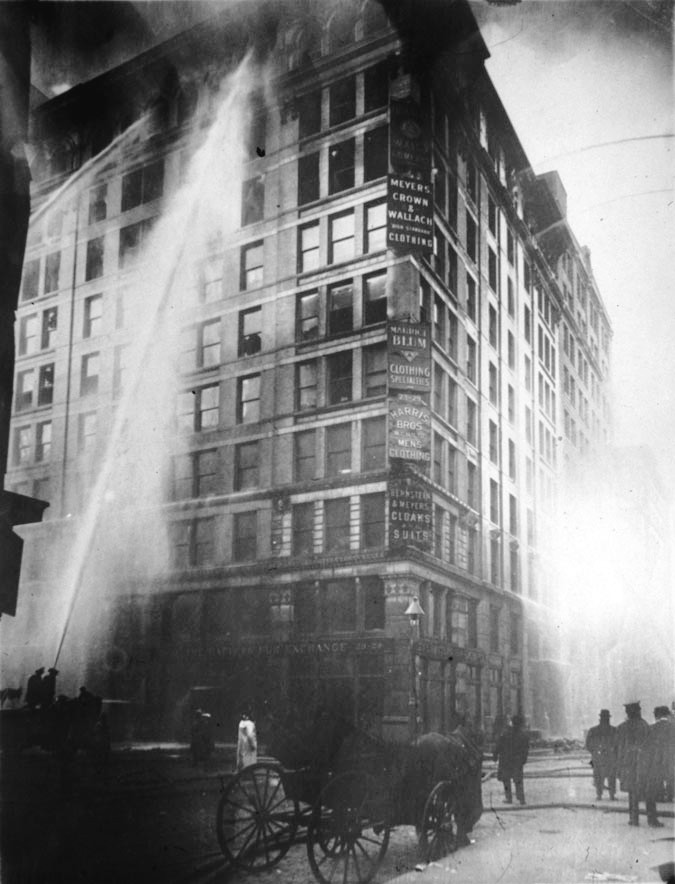It was March 25, 1911, in New York City. It was a Saturday afternoon just like any other at the Triangle Shirtwaist factory, where young immigrant women sat in front of sewing machines, day in and day out, sewing. But on that day a fire broke out, causing the deaths of 146 garment workers. Among those who died in the flames and smoke were 123 women and 23 men.1 Many even jumped or fell to their deaths out the windows, making this event a man-made disaster and one of the deadliest industrial disasters of all time.

The factory was located in the Asch Building at Washington Place in Greenwich Village, one of the wealthiest neighborhoods in the city. The factory occupied the eighth, ninth, and tenth floors of the ten-story building. Max Blanck and Issac Harris were the owners of the factory, and their company was known as the largest firm in the business at the time. They styled women’s blouses known as “Shirtwaists,” which were paired with tailored skirts. This attire had become the standard in fashion for women in the early twentieth century. They were also known to resemble men’s shirts. When it came to their workers, they had hired operators who then contracted out for factory workers. The company itself only dealt with the contractors, and there was no fixed rate of pay for the workers.2 At the time, the factory employed about five-hundred employees, mostly young immigrant women who were of Italian or Jewish descent. These women worked up to eleven-hour shifts on weekdays, and twelve-hour shifts on Saturdays, and they earned between $7-$12 dollars for a 52-hour week. Many of these women were the breadwinners of their household, and their income was sometimes not sufficient to cover their needs.
Towards the end of the workday on that Saturday evening in 1911, a fire broke out around 4:00 pm. The fire started in a scrap bin under one of the cutter’s tables on the eighth floor from what is believed to have come from a cigarette. A manager tried to put the fire out with a hose but the hoses valve was rusted shut, and rotten away. The fire spread quickly and the workers panicked. There was one fire escape that quickly collapsed, and four elevators, which out of the four only one was working. The elevator held twelve people at a time, and it managed to make four rescue trips before it broke down.3 With no other alternatives available, people began throwing themselves out the windows, and some were even crushed to death trying to get out. Workers tried to take the stairs, but the exit doors only opened inward and were kept locked by factory management to prevent theft by the workers, as the managers would check their workers belongings every day before they left for the day.

Celia Saltz Pollack, a survivor of the 1911 Triangle Shirtwaist Fire said,
I remember on that day there was a lot of singing and happiness in the shop because it was the end of the week and we got paid. We were soon all going to go home. When the fire started I was sitting at my machine. I looked up and saw the fire near the cutting tables but I did not think it was so terrible. What was terrible was that the fire spread in a split second.
By the time the firefighters arrived, they came to the realization that their ladders could only extend up to the sixth or seventh floors. With no other option, sixty-two workers jumped and fell to their deaths, while the remaining died from the smoke and flames within the building.4

This fire not only pushed issues of unsafe factories and immigrant exploitation into the public consciousness, but for the first time the fire allowed for attention to be brought to deplorable conditions of New York factories.5 Women obtained well deserved attention onto current work conditions and safety measures in the workplace. Although the Triangle Shirtwaist Factory fire brought a feeling of resentment and heartbreak to many, this event and its victims will always be remembered.
- Ric Burns, “Triangle Shirtwaist Fire,” New York Times (1923-Current File), Nov 24, 1999. ↵
- Jonathan Fink, “Conflagration and Wage: The Triangle Shirtwaist Factory Fire, 1911,” TriQuarterly, no, (2009): 135-136. ↵
- Gale Encyclopedia of U.S. Economic History, s.v. “Triangle Shirtwaist Fire,” by Thomas Carson and Mary Bonk. ↵
- Mia Lynn Mercurio, Régine Randall, “Tributes Beyond Words: Art Educators’ Use of Textiles to Memorialize the Triangle Shirtwaist Factory Fire.” Journal for Learning through the Arts no. 1 (2016): 4-5. ↵
- Albert Marrin, Flesh and blood so cheap: The Triangle fire and its legacy (New York: Alfred A. Knopf, 2011), 23-25. ↵




135 comments
Natalia Flores
I’ve never heard of this fire and to read about it sounds shocking. It’s shocking because these women were trapped and either burned to death or jumped to their deaths. It is also disturbing that the conditions were so inadequate and terrible that they couldn’t turn on the water to put it out when it first started. On top of that, the ladders that the fire department had weren’t tall enough to reach the upper floor. I’m glad that they’ve brought workplace regulations, but it’s sad that they didn’t happen soon enough.
Monica Avila
I first heard of this story in high school in my U.S. history class and was taken aback by how bad these women were taken advantage of.
Therefore, the story shocks me everytime I read it. It is insane how so many women died because of a safety hazard. While tragic, it is comforting to know that this lead to labor laws and safety regulations. No worker deserves these kind of harsh conditions. A factor that was centered one was their ethnicity and gender which contributed to the lack of attention to safety regulations. No matter the case these workers did not deserve their death.
Angelica Padilla
I remembered learning about the Triangle Shirtwaist Factory back in high school. I want to say that this is the reason why business and stores aren’t allowed to lock door during operating hours. This is heartbreaking reading how people would jump out the windows so that they wouldn’t be stuck in the building. There were so many ways that the situation could have been prevented. I’m glad that there has been regulations and laws that now help prevent situations like this to happen.
Anna Guaderrama
I remember learning about the Triangle Shirtwaist Factory Fire back in like middle school and it always baffled me how such a thing could happen and no one ever thought about preventing it or the possible outcomes of what could have happened if something like that were to happen in the first place. I remember seeing documentaries and videos over it and some of the commentary was just so sad to hear because those were people, the just wanted to make their money and instead they got caught in the fate of the factory itself. I’m just glad to see that they learned after having such an accident happen and created regulations to prevent something like this from happening again.
Kimberly Simmons
I had never heard of this disaster before reading this article. I can’t imagine how scared these workers must’ve been – especially the ones who had no choice but to jump out of a window. Before health codes were put in place, factories like these must’ve been a horrific place to work in. Luckily, this unfortunate event pushed for safety regulations in factories with unworkable conditions.
Kailan Pena
It’s tragic that so many people lost their lives as a result of this incident and more so that it was caused by such an avoidable and ignorant mistake. I feel deeply for the people that felt they had no choice but to jump out of the building, I’d imagine that decision was not easily made and I feel horrible for the survivors that endured trauma as a result of seeing those horrendous deaths.
Brandon Martinez
This article was a real eye opener, seeing how far we’ve gotten today. This article informed me of conditions of working at the time of 1911, and also makes me think of 9/11 the way the disaster was handled. People were jumping out of the building so they didn’t get consumed by the fire. This disaster also happened in one of the wealthiest parts of town back then, and if their policy about cigarettes was updated like today’s, about smoking in buildings, this fire could have been prevented. This was really moving.
Cheyanne Redman
Prior to reading this article, I had a small amount of knowledge on what this fire really was and how much of an impact it made on further safety regulations. After reading, my heart aches for the 146 people who lost their life over greed from the factory owner, but in light of sadness, regulations were set forth to protect and enforce safety precautions to limit this exact situation from happening. I couldn’t imagine being in the position to either burn to death or jump to my death, I just couldn’t imagine how hard it was for them. The article itself was very well written, it presented facts and even real stories from the incident. Great Job.
Seth Castillo
This fire created an awareness of safety in factories. No one was prepared for something like that to happen. The firefighters never even had a ladder tall enough to reach the top floor. The lack of safe working conditions meant many of those workers were doomed from the start. Nowadays the fire department and staff of these buildings know exactly where to go and do in the event of a fire. The deaths of so many people created a movement for safety that changed working conditions for the better across America.
Jose Figueroa
It has sad to see that sweatshops like this still exist in our world today, particularly in Asian countries. The worst part of this event was that it could have been easily avoided. Greedy factory owners were so worried about losing a small amount of money due to theft, that they caused 146 workers to lose there life. On the bright side we now have laws in place to ever prevent a tragedy like this to ever happen again.